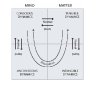ec1968
Jedi
obyvatel said:Speculation Alert - measures high on the "out on a limb meter"
I would speculate that there are rules in the realm of the mind like there are rules in the realm of matter. The mechanistic model of matter works well in the macroscopic world, but the model breaks when things start moving too fast or become too small or too big. That brings us to relativity and quantum mechanics. "Newtonian" reality can be extrapolated from QM but not vice versa. Newtonian reality is deterministic, governed by differential equations. Having knowledge of present state and initial conditions, the equations can theoretically be solved. There are places where serious non-linearity or chaotic dynamics creep in - like the famous 3-body problem and a host of other examples. Also, from a practical standpoint, the determinism holds for aggregates and ensembles rather than individual elements. A cheesy example - when we heat a pot of water, we can predict how much heat and how long it would take to turn the entire mass of water to vapor. If we heat it for less time, there will be water left in the pot. We can predict how much water will be left. However, if we go down to level of individual water molecules, what would determine whether an individual water molecule would be turned to vapor within that time or stay as water? The fate of individual water molecules is difficult (if not impossible) to predict with absolute certainty.
We know much less about the rules in the realm of the mind. Jung pioneered the field and brought archetypes back into public awareness. He also came up with the principle of complementarity - not unlike what QM talks about. Similarly, Jung's synchronicity concept - which he called "acausal orderedness" has an interesting parallel in non-local quantum entanglements.
When we say "reality", we implicitly assume space-time-mass structure and study changes there. Another cheesy example - this time from math - take real numbers. We can try mapping reality with real numbers. Yet, mathematicians would tell us, real numbers are not enough. The field of real numbers is "not closed" since you can do operations with real numbers which have no solution within the field of real numbers. Enter complex numbers - where an "imaginary" component is added to the real number field. This complex number field is "closed" - adding the imaginary component means you can do any (algebraic) operation with complex numbers and the result will still remain within the field of complex numbers.
The basic wave function of QM is described with complex numbers. The "reality", as in measurable physical parameters, obtained from "collapsing the wave function", afaik ultimately involves computing what is considered the "real" part of the complex wave function - using conjugation. ( link - hyperphysics.edu ). Conjugation is a way of combining (multiplying) the complex number with its mirror image wrt to the imaginary axis such that the result does not contain an imaginary part anymore but contains only the real - "measurable" or "observable" part. Thus we get "reality" from physics. We can wonder what happened to the imaginary part that we threw out so cleverly - we use it but then ignore it when it comes down to so-called "objective-as-in-measurable/observable" reality.
Why ramble on this point, especially as I am not a mathematician or a physicist or a psychologist ? Not justifying the rambling entirely but I think there is a parallel in the field of psychology. What we observe in reality is what we do or say within the space-time-mass structure. However, it is easy to see that different people can do or say the same thing in a given situation for entirely different reasons (just as results obtained from reduction of complex wave functions to real numbers do not provide complete information about the original complex numbers and we can arrive at the same "real" results from the combination of different complex numbers). Sometimes, we can give a reason but as books like "Strangers to Ourselves - The Adaptive Unconscious" tell us, we can be completely wrong. What I am getting at is that there could be a correspondence between the complex (real+imaginary) numbers, complex conjugation operation to arrive at "real" numbers and the unconscious and what we do/say in "real" life. What can seem deterministic (or the opposite) from the "real number/measurable-observable reality" perspective may not be cut and dry from the "complex number/unconscious" perspective. As with Newtonian/materialistic world view, we may be right a lot of the time - but in certain limits, our rightness will break down, especially if we are married (another word for conjugation btw) to only the measurable/observable reality (real) part of the overall equation.
If the above reads obtuse or nonsense-like, I am sorry. I decided to go back to add the "speculation alert" as a mitigation effort.
Obyvatel
Your words may well be speculative, but your argument is very well made and makes sense to me. Thank-you.

